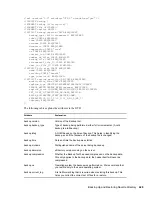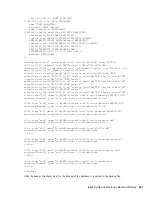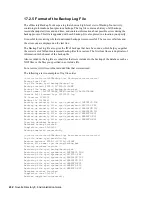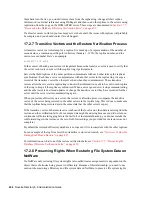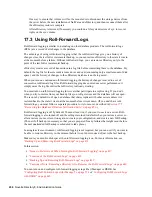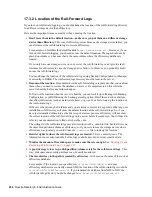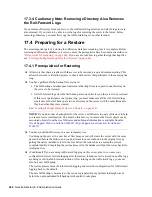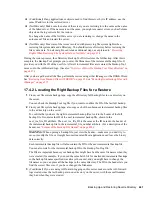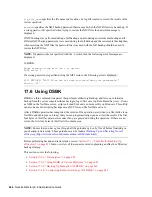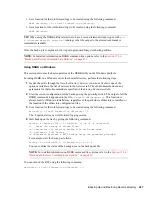
Backing Up and Restoring Novell eDirectory
439
n
ov
do
cx (e
n)
22
Ju
n
e 20
09
When you change the location, the new directory is created immediately, but a roll-forward log
is not created there until a transaction takes place in the database.
When restoring, all the necessary roll-forward logs must be in the same directory.
For
more information, see
Section 17.4, “Preparing for a Restore,” on page 440
.
17.3.3 Backing Up and Removing Roll-Forward Logs
If left unchecked, roll-forward logs can fill up the disk partition/volume where they are placed. If
roll-forward logs cannot be created because no more disk space is available, eDirectory stops
responding on that server. We recommend that you periodically back up the log files and remove
unused logs from the server to free up disk space.
To identify, back up, and remove roll-forward logs that are safe to remove:
1
Make a note of the name of the last unused roll-forward log.
You can find out the name of the last unused roll-forward log in the following ways:
In iManager, click
eDirectory Maintenance
>
Backup Configuration
and read the filename
displayed.
In the DSBK Client, enter the getconfig backup command. See
“Configuring Roll-
Forward Logs with DSBK” on page 449
for instructions.
The last unused roll-forward log is the most recent roll-forward log that the database has
completed and is no longer using to record transactions. It's called the last unused roll-forward
log because the database has finished writing to it and has begun a new log file, so it does not
need to have this one open any more. (The current roll-forward log in which the database is
recording transactions is in use and is still needed by the database.)
2
Do a file system backup of the roll-forward logs, to put them all safely on tape.
3
Remove the roll-forward logs that are older than the last unused roll-forward log.
WARNING:
Keep in mind that you must be cautious when removing roll-forward logs from
the server. Compare carefully with your tape backup to make sure you have a backup copy of
everything you delete.
The last unused roll-forward log indicates which file the database has just completed and
closed. It does not indicate whether it's safe to remove that file from the server. You must make
sure that you remove only files that you have a tape backup for.
If you need to retrieve any of the roll-forward logs from tape for use in a restore because you have
placed some of them on tape backup, keep in mind the following issues:
As with any roll-forward logs used for a restore, log files retrieved from file system backup
tapes must be placed in the same folder as the other roll-forward logs, local to the server being
restored.
You must compare time stamps for any files that are duplicated on the tape and on the server.
Use the latest one, the one on the server, if the time stamps are not the same. For example, the
roll-forward log file that was in use by the database during the time of the file system backup
will be incomplete on the tape; the latest and complete version of that file will be on the server.
Summary of Contents for EDIRECTORY 8.8 SP5
Page 4: ...4 Novell eDirectory 8 8 Administration Guide novdocx en 22 June 2009...
Page 72: ...72 Novell eDirectory 8 8 Administration Guide novdocx en 22 June 2009...
Page 118: ...118 Novell eDirectory 8 8 Administration Guide novdocx en 22 June 2009...
Page 130: ...130 Novell eDirectory 8 8 Administration Guide novdocx en 22 June 2009...
Page 188: ...188 Novell eDirectory 8 8 Administration Guide novdocx en 22 June 2009...
Page 222: ...222 Novell eDirectory 8 8 Administration Guide novdocx en 22 June 2009...
Page 240: ...240 Novell eDirectory 8 8 Administration Guide novdocx en 22 June 2009...
Page 264: ...264 Novell eDirectory 8 8 Administration Guide novdocx en 22 June 2009...
Page 290: ...290 Novell eDirectory 8 8 Administration Guide novdocx en 22 June 2009...
Page 322: ...322 Novell eDirectory 8 8 Administration Guide novdocx en 22 June 2009...
Page 540: ...540 Novell eDirectory 8 8 Administration Guide novdocx en 22 June 2009...
Page 548: ...548 Novell eDirectory 8 8 Administration Guide novdocx en 22 June 2009...
Page 616: ...616 Novell eDirectory 8 8 Administration Guide novdocx en 22 June 2009...





